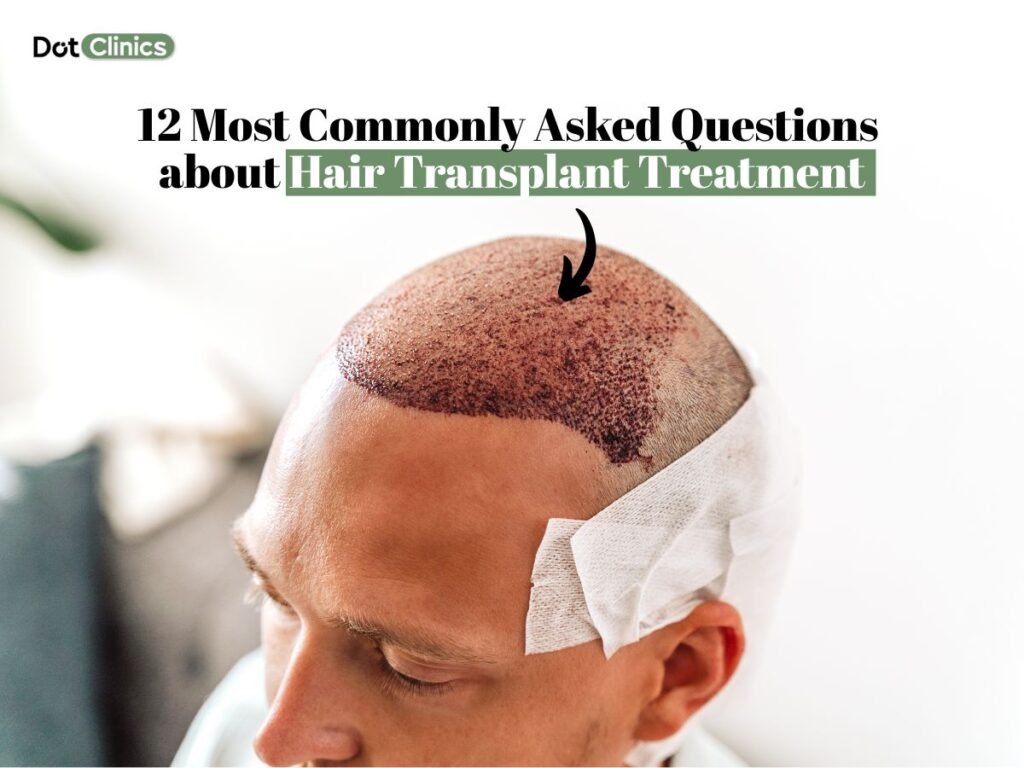Hair loss can happen to anyone – men, women, young or older. There are tons of products available in the market that claim to be a miracle solution but hair transplant treatment has emerged as the most promising permanent solution to hair loss. If you’re suffering from bald spots, thinning hair, or receding hairlines, a hair transplant treatment can restore your confidence in your appearance.
But evenly so, plenty of people are anxious or unsure of how the treatment works. Questions such as “Does it hurt?”, “Does it actually work?” or “Will the hair look real?” are completely normal and perfectly valid. Therefore, in this blog, we will be answering the 12 most frequently asked queries regarding a hair transplant treatment.
1. What is a hair transplant?
A hair transplant is a surgical method in which your healthy hair (typically obtained from the back of your head) is transplanted to the region where you are losing hair.
It’s done with local anesthesia, so you’re awake but have no pain. Here are the two most common hair transplant techniques by far:
- FUE (Follicular Unit Extraction): Hair is taken one by one and placed in bald areas.
- FUT (Follicular Unit Transplant): A strip of skin with hair is removed, hair roots are separated and transplanted.
Both methods are safe and effective. Your doctor will determine which is right for you.
2. Is a hair transplant permanent?
Yes, hair transplant is typically a permanent hair loss solution. This is because the hair follicles transplanted are generally from regions of the scalp that are genetically resistant to balding, like the back or sides of the head. These follicles are resistant when relocated to thinning or balding regions, allowing them to continue growing hair chronically.
However, it’s crucial to remember that though the transplanted hair is permanent, its final look can change throughout the years. However, aging, hormones, and the development of surrounding hair loss on areas not transplanted can affect overall hair density and may require future work or treatments.
A ten year retrospective study published in the Hair Transplant Forum International estimated the long-term hair transplant survival of individuals who underwent the hair transplant procedure over a decade ago. It determined that while the transplanted hairs typically stayed but, some patients found them thinning – whether due to the selection of donor sites or general hair well-being. This reinforces how critical correct technique and post-operative management are for long-term success. Read full Study.
This study reminds us that hair transplants are permanent. However, it is essential to understand that their long-lasting success is dependent on the surgical technique used, patient condition, preventable medical issues, and the maintenance of the transplant area after surgery.
3. Is the Hair Transplant painful procedure?
No, treatment itself is not painful. Before the procedure, you will receive a local numbing injection. That means you aren’t going to feel any pain when they do the treatment, although you may feel some pressure or movement.
Mild soreness or tightness may occur for a few days afterward, but it is often easily controlled with prescribed medications.
4. How long does the procedure take?
The length of time varies based on the number of hairs being transplanted. Generally:
- Small areas: 4 to 6 hours
- Full scalp or other big areas: 6 to 8 hours (occasionally done over two sessions)
You could chill, watch some videos on your phone, and even talk with the team while doing so.
5. What is the recovery time?
Recovery time is relatively fast in comparison to other surgeries.
- You can go home the same day.
- It can lead to mild swelling and scabbing for a day or two.
- You may return to work in 3 to 5 days (unless your work is very physical).
- You will need to avoid heavy exercise for approximately 2 weeks.
Complete healing occurs over several weeks, and hair grows slowly after that.
6. When will I see the results?
Hair doesn’t grow overnight and that’s totally normal. Here’s a quick timeline of what to expect:
- First 2-3 weeks: The transplanted hair might fall out – this is normal.
- Month 3-4: New hair starts to grow.
- Month 6: You’ll see clear improvement.
- 12 months: Full results are visible with natural thickness and density.
Patience is key here.
7. Will the new hair look natural?
Yes, if performed by an experienced doctor, the results look 100% natural. That is because the process uses your own hair, only redistributing it to areas that are thinning or bald.
One of the most important aspects of creating a natural look is the placement of the hairline. A correct hairline design must imitate the natural slightly-irregular hair patterns of your original hair even taking into account aspects like your facial shape, age, and natural hair growth direction. Hairs grafts are placed at a proper angle, so that they mesh well with the native hairs.
The choice of donor hair that closely matches the texture, density, and color of the recipient area also helps to create a natural look. All of these factors can help make the results practically untraceable.
8. Are there any side effects with Hair Transplant Treatment?
As like any medical procedure, hair transplant can carry some temporary side effects. These are generally mild and resolve on their own with appropriate care:
- Swelling: For a few days following the procedure, your forehead or face may puff up slightly.
- Itching: You may feel some itchiness as your scalp heals. This is normal but do not scratch as you will disturb the new hair grafts.
- Scabbing: Small crusts may form where hair was transplanted. They typically fall off within a week.
- Bleeding: Minor bleeding can occur from the tiny cuts made during the transplant. Applying gentle pressure usually stops it.
- Infection: The scalp can rarely become infected. Maintaining the area clean, and following your doctor’s instructions helps prevent this.
These side effects are usually short-lived and their impacts are manageable. Follow your surgeon’s aftercare instructions properly for a smoother recovery.
9. How much does Hair Transplant cost?
Hair transplant price in Pakistan is decided based on number of grafts, treatment procedure and clinic’s location and reputation.
Hair Transplant cost in Pakistan (by number of Grafts)
| Number of Grafts | Estimated Cost (PKR) |
| 1000 Grafts | 40,000 to 60,000 |
| 1500 Grafts | 60,000 to 80,000 |
| 2000 Grafts | 80,000 to 100,000 |
| 2500 Grafts | 100,000 to 120,000 |
| 3000 Grafts | 120,000 to 140,000 |
| 4000 Grafts | 160,000 to 180,000 |
| 5000 Grafts | 200,000 to 300,000 |
| 10,000 Grafts | 400,000 to 600,000 |
Factors Influencing Cost
1. Applied Technique: FUE is more expensive procedure because its more technologically advanced and more demanding in time as compared to FUT.
2. Location of Clinic: Major cities like Islamabad, Lahore, and Karachi will likely have a higher cost as compared to small cities.
3. Surgeon’s Expertise: Renowned surgeons with extensive experience often come with higher fees.
4. Extra Services: The cost of post-operative care, medications, and follow-up sessions can also contribute to the overall bill.
City-wise Cost Estimates
- Islamabad: PKR 100,000 to 400,000
- Karachi: PKR 70,000 to 350,000
- Lahore: PKR 80,000 to 300,000
- Multan: PKR 70,000 to 110,000
These are rough estimated price ranges; actual costs will vary depending on individual cases and clinic policies.
10. Is there any age limit?
Hair transplant is mostly done on adults between the ages of 25 to 50. Why not before 25? Because early hair loss might still continue and new bald patches can form.
Your doctor will first check the root cause of your hair loss before suggesting a transplant. Sometimes, medical treatment is better for younger patients.
11. Can women get hair transplants too?
Yes, absolutely. Women often experience hair loss, particularly after childbirth, menopause or hormonal problems. Women may face:
- Widening part lines
- Patchy hair loss
- Thinning over the crown
Hair transplant is safe for women too. In fact, many female celebrities and influencers have had it done and are open about it now.
12. What should I do before and after the treatment?
Before the transplant:
- No Smoking and Alcohol for 1 week.
- Avoid blood-thinning medications (unless your doctor advises you to take them)
- Wash your hair on the day of your surgery.
After the transplant:
- Sleep with your head elevated
- Avoid touching or scratching the area
- Use prescribed sprays or shampoos only
- Avoid sun, sweating, or hats for 2 weeks
- Follow your doctor’s post-care plan
Following these tips helps avoid complications and gives the best results.
Conclusion
Hair transplant treatment is not just about appearance – it’s about self esteem, self confidence and social approval. Whether you’re tired of hiding bald patches under hats, or you just want to feel young again, this treatment can change your life.
It’s not a risky or painful process anymore – modern methods are safe, reliable, and permanent. But make sure to choose the right doctor, ask questions, and follow the proper aftercare. Your dream hair is just a few steps away!
FAQs
Q1. Can I wear a cap or helmet after the transplant?
Not for the first 2 weeks. After that, soft caps may be okay but ask your doctor first.
Q2. Can hair fall again after transplant?
The transplanted hair stays, but your other hair might still thin. Regular checkups can help.
Q3. Can I color or dye the new hair?
Yes, after 1–2 months when the new hair is fully grown and healthy.
Q4. Will it help with patchy beards or eyebrows?
Yes! Beard, moustache or eyebrow hair transplants can also be performed.
Q5. Is it safe for diabetic or heart patients?
It depends. A detailed consultation and medical check-up is a must before the procedure.



